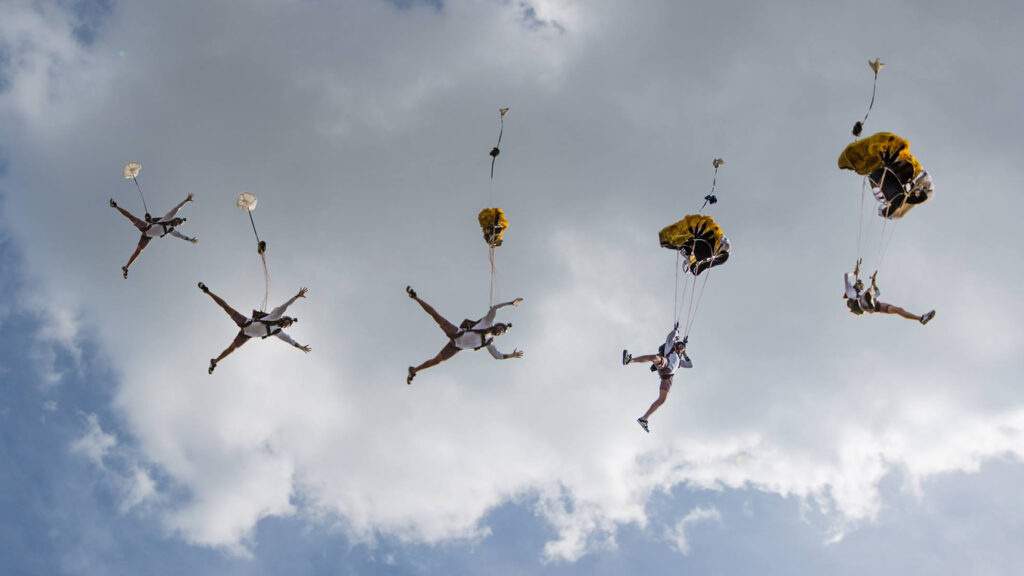Should I land off ? … or try to make it back to the DZ?
The answer to this question can be difference between a safe landing and a trip to the hospital…

Scenario:
You’re under a good canopy at 2,000 feet. You are downwind of the drop zone and aren’t sure you can make it to the landing area. Between you and the drop zone are trees, brush, power lines, and likely all manner of unpleasant critters. Behind you is a wide open field.
What do you do?
1) Get on your rear risers or toggles, trim out your canopy for a flat glide, pull up your knees to reduce drag, and try to clear the obstacles.
2) Start looking for an alternate landing area.
3) Aim for the center of the biggest tree so you can grab onto it when you land there and not fall out of it.
4) Transfer your landing pattern to the open field behind you and aim for the center of it.
Remember back to your student training… at what altitude were you taught to select a suitable landing area? That’s right – 2,000 feet. Above 2,500 feet you should have done a controllability check and begun evaluating potential landing areas (free of hazards) nearby.

So let’s look at the possible answers…
1) Get on your rear risers or toggles, trim out your canopy for a flat glide, pull up your knees to reduce drag, and try to clear the obstacles.
Good answer – if you were well above 2,000 feet, not AT 2,000 feet. By 2,000 feet, you should have already selected an easily reachable, safe landing area.
2) Start looking for an alternate landing area.
By 2,000 feet, you should have already done this so you can make a choice with sufficient altitude to achieve a good pattern starting point.
3) Aim for the center of the biggest tree so you can grab onto it when you land there.
This is only a good plan if you have failed to select an appropriate landing area in time to reach it. It’s an emergency technique, not a plan.

Image by Erik Aasberg
4) Transfer your landing pattern to the open field behind you and aim for the center of it.
YES, YES, YES! By 2,000 feet, you should have decided on a safe area to land, whether that is on the drop zone or not. Don’t get fixated on the drop zone landing area; be realistic about whether you are certain you can make that area. If not, look all around you. Like they’re always telling us on commercial airline flights, the safest emergency plan may be behind you.
Select a suitable area, transfer your pattern to that area, and land just as if you would if you were “home.” On the way down, take a quick look around for the easiest way to walk to the drop zone or the nearest road for a pickup.
Taking your phone when jumping (with the DZ number saved in it) can help you get a ride and communicate with the DZ that you’re ok. If it’s a Burble DZ they have a cool feature in the Burble App that lets the DZ know where you are!

Image by Craig Poxon
Be aware even if an open field, your alternate landing area is likely to have a few hazards. It’s important to be aware of these, but don’t get target fixation and accidentally steer towards them. Remember to PLF if you can’t see the ground properly (e.g. in crops or vegetation) as it could be further than you think – nobody’s there to see your cool running landing so stay safe and take a roll!
Safe landings and blue skies!

Article originally on Skydive Spaceland Houston’s website here, reprinted with permission.
Further safety articles:

- Land ALONE – written by Lesley Gale
- Take CHARGE! – written by Dan Brodsky-Chenfeld
- USPA Malfunctions Video Series – by USPA
- What is your Decide and Act Altitude? – written by Julian Barthel
- Four Critical Altitudes – written by Bill Coe
- Malfunctions Flowchart – written by Julian Barthel
- 7 Protective Layers – Part 1 and Part 2 – written by Julian Barthel


